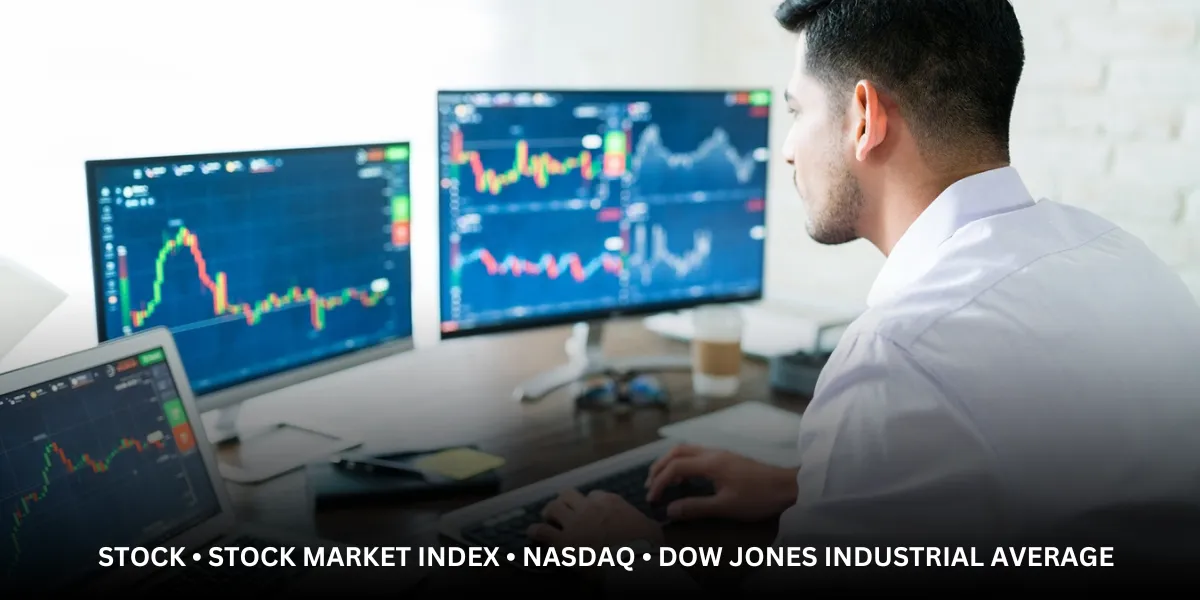Stock • Stock market index • Nasdaq • Dow Jones Industrial Average Major Stock Indexes in the United States Started the Trading Session on Monday Mostly Lower As the new trading week kicked off, major stock indexes in the United States experienced a mixed opening. Investors were on edge, awaiting key economic reports like the Gross Domestic Product (GDP) and Personal Consumption Expenditures (PCE) price index scheduled for release later in the week. In addition, several high-profile companies, including FedEx Corporation, Levi Strauss & Co., BlackBerry Limited, Walgreens, and Nike Inc., were expected to publish their quarterly earnings reports, adding to the market’s cautious sentiment.
The Dow Jones Industrial Average (DJIA) managed a slight rise of 0.23% at the opening bell, buoyed by International Business Machines Corp. (IBM) climbing 1.22%. Meanwhile, the Nasdaq 100 saw a dip of 0.27%, with Qualcomm Inc. leading the declines at 3.73%. The S&P 500 edged down by 0.07%, with ResMed Inc. plunging 7.52%. In the currency markets, the euro strengthened by 0.44% against the dollar, trading at $1.07395 as of 9:28 am ET.
Understanding Stock Market Indexes
Stock market indexes serve as barometers for the overall health of the stock market and the economy. They track the performance of a specific group of stocks, representing a portion of the market. By looking at these indexes, investors can gauge market trends and make informed investment decisions. Think of them like the pulse of the financial world, providing insight into whether the market is thriving or facing challenges.
The Dow Jones Industrial Average (DJIA)
The Dow Jones Industrial Average (DJIA) is one of the oldest and most widely recognized stock market indexes. It includes 30 large, publicly-owned companies based in the United States. The DJIA is often seen as a proxy for the overall market health, given its inclusion of major companies from various industries. On Monday, the DJIA saw a modest rise, largely driven by the performance of IBM, which climbed 1.22%.
Key Components of DJIA
The DJIA’s components are carefully selected to represent the broad sectors of the U.S. economy. Companies like Apple, Boeing, and Goldman Sachs are among its constituents. The performance of these companies can significantly influence the index’s movement.

Nasdaq 100
The Nasdaq 100 is a stock market index made up of 100 of the largest non-financial companies listed on the Nasdaq stock exchange. It is known for its high concentration of technology firms, making it a tech-heavy index. On the first trading day of the week, the Nasdaq 100 fell by 0.27%, with Qualcomm Inc. experiencing a significant drop of 3.73%.
Tech Sector Dominance
The Nasdaq 100 is heavily influenced by tech giants like Apple, Microsoft, and Amazon. This dominance means the index often mirrors the performance of the technology sector. When these companies do well, the Nasdaq 100 typically rises, and when they face challenges, the index tends to drop.
S&P 500
The S&P 500 is another major stock market index that includes 500 of the largest companies listed on U.S. stock exchanges. It is considered one of the best representations of the U.S. stock market and the economy. On Monday, the S&P 500 edged down slightly by 0.07%, with notable declines from companies like ResMed Inc., which plunged 7.52%.
Broad Market Representation
The S&P 500 covers a wide range of industries, from technology and healthcare to finance and consumer goods. This broad representation makes it a key indicator of the overall market performance.
Economic Indicators: GDP and PCE
This week, investors are closely watching for the release of two critical economic reports: the Gross Domestic Product (GDP) and the Personal Consumption Expenditures (PCE) price index. These indicators provide valuable insights into the state of the economy and inflation trends.
Gross Domestic Product (GDP)
The GDP report will shed light on the economic growth of the country. A higher GDP indicates robust economic activity, while a lower GDP may signal a slowdown.
Personal Consumption Expenditures (PCE) Price Index
The PCE price index measures the changes in the prices of goods and services consumed by households. It is a key indicator of inflation and helps the Federal Reserve make decisions about interest rates.
Corporate Earnings Reports
Several prominent companies are scheduled to release their quarterly earnings reports this week. These reports can significantly impact stock prices and investor sentiment.
Companies to Watch
- FedEx Corporation: As a major player in logistics, FedEx’s earnings report will be closely scrutinized for insights into global trade and economic activity.
- Levi Strauss & Co.: This report will provide a snapshot of consumer spending trends in the apparel sector.
- BlackBerry Limited: Investors will look for updates on BlackBerry’s transition from smartphones to software and services.
- Walgreens: The performance of this pharmacy giant will offer clues about the healthcare sector’s strength.
- Nike Inc.: Nike’s earnings will be a key indicator of consumer spending and brand strength in the athletic apparel market.
Performance of Major Companies
On Monday, specific companies had a notable impact on the stock market indexes.
International Business Machines Corp. (IBM)
IBM saw a rise of 1.22%, contributing to the Dow Jones Industrial Average’s slight gain. IBM’s performance often reflects trends in the technology and consulting sectors.
Qualcomm Inc.
Qualcomm experienced a significant drop of 3.73%, dragging down the Nasdaq 100. This decline could be due to various factors, including earnings reports, market sentiment, or sector-specific news.
ResMed Inc.
ResMed’s 7.52% plunge affected the S&P 500. This drop could be attributed to company-specific issues, such as disappointing earnings or adverse news.
Market Reactions and Investor Sentiment
Investor sentiment plays a crucial role in the movement of stock market indexes. The anticipation of economic reports and earnings releases can lead to cautious trading and market volatility.
Cautious Optimism
While some investors may remain optimistic about economic growth and corporate earnings, others might adopt a more cautious approach, leading to mixed market movements.
Currency Market Movements
In addition to stock market indexes, currency markets also saw notable movements. The euro gained 0.44% against the dollar, trading at $1.07395.
Euro vs. Dollar
The strength of the euro compared to the dollar can be influenced by various factors, including economic data, interest rates, and geopolitical events. A stronger euro can impact U.S. companies that export goods to Europe, making their products more expensive for European consumers.
The Bigger Picture: Global Market Influence
Global events and trends can also influence U.S. stock market indexes. Economic data from other countries, geopolitical tensions, and international trade agreements all play a role in shaping investor sentiment and market movements.
International Trade
Trade relations between the U.S. and other countries can impact the performance of stock market indexes. Positive developments in trade agreements can boost investor confidence, while trade disputes can lead to market uncertainty.
Conclusion
As the trading week began, major U.S. stock indexes displayed mixed performances, reflecting the cautious sentiment among investors. With significant economic reports and corporate earnings on the horizon, the markets are likely to remain volatile. Keeping an eye on key indicators and company performance will be crucial for navigating this uncertain landscape.
FAQs

